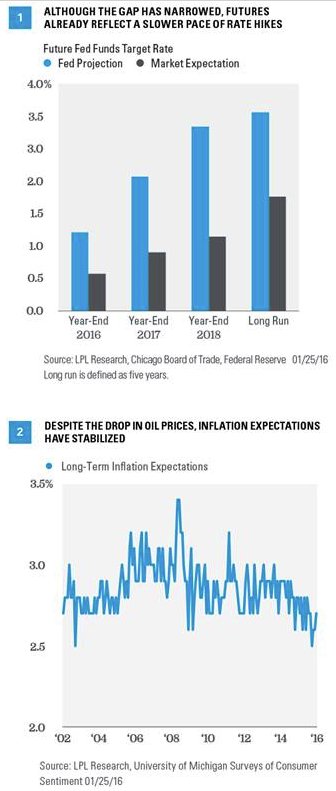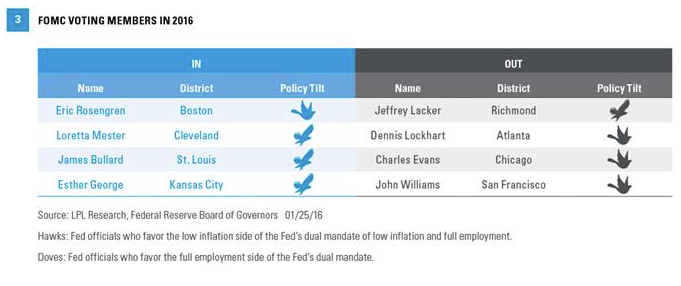Federal Reserve (Fed) policymakers face a difficult task this week. Although it is not expected that they will raise rates again as soon as this week’s meeting, they have to communicate the Fed’s policy intentions without the benefit of a press conference by Fed Chair Janet Yellen or a new set of economic and rate forecasts from the members of the Federal Open Market Committee (FOMC). Even in typical times, Fed communications can be subject to misinterpretation from overly anxious financial market participants often causing large — and ultimately, unwarranted — swings in prices of financial assets over a short period. While not anywhere near extremes seen in 2007 – 09, or even in 2011, financial markets have started the year off in a fragile state, concerned about the price of oil, global growth, China, and the potential for devaluations across the emerging markets. It is against this tumultuous backdrop that the Fed has to hand down a decision.
In short, the Fed has to “talk down” its own dot plots without causing more panic in markets via “the Fed knows something we don’t know” channel. Fed Chair Yellen and the rest of the FOMC were guilty of this at the September 2015 FOMC meeting when they didn’t raise rates, citing “global financial conditions” as the main reason. During the press conference following the FOMC statement released in September 2015, Yellen sounded overly concerned about global growth, and especially China, and those concerns spooked markets. A week or so later, Fed Chair Yellen delivered a speech on the economic and policy outlook in Amherst, MA, and downplayed those concerns. Hopefully, Yellen and the FOMC have learned that lesson.
However, the Fed and the market remain far apart where the fed funds rate will end up this year [Figure 1]. As noted below, the market now sees just one more 25 basis point (0.25%) hike this year. The Fed, as of December 16, 2015, at least, still sees four 25 basis point hikes. The FOMC has only its statement this week to help close that gap. The statement the FOMC releases this week will have to continue to stress that future rate hikes are data dependent, meaning that the Fed will raise rates if it sees continued improvement in the labor market and if it is confident that inflation is moving toward the 2% target, thus the statement is likely to include the line: “However, the actual path of the federal funds rate will depend on the economic outlook as informed by incoming data.”
The statement will also have to acknowledge the recent market volatility, but keep it in perspective, and will likely point out that recent data on the labor market have been solid, and inflation expectations — a key metric for the Fed — have stabilized despite the recent drop in oil [Figure 2].
Under usual circumstances, an FOMC meeting can cause consternation in financial markets. Given the volatility seen in financial markets and in global economies so far in 2016, and the fact that the Fed only has its statement to communicate its views, this week’s FOMC meeting is even more important.
What Is the Schedule of Events for the Fed This Week?
The Fed holds the first of eight FOMC meetings of 2016 this Tuesday and Wednesday, January 26 – 27, 2016. The meeting will be followed by an FOMC statement at 2:00 p.m. ET on January 27, 2016, but there is not a press conference by Fed Chair Yellen nor will the FOMC release a new set of economic forecasts (for gross domestic product [GDP], the unemployment rate, inflation, and fed funds projections). Unfortunately, the FOMC statement is the only way the FOMC will communicate its views on the U.S. and global economy and the expected path for the fed funds rate to frazzled investors this week.
Has the “Market” Priced in a Rate Hike at This Week’s Meeting?
As of Monday, January 25, 2016, the fed funds futures market has priced in virtually no chance of a rate hike at this week’s meeting. In fact, since the Fed rate hike on December 16, 2015, the fed funds futures market has moved from pricing in just over two 25 basis point rate (0.25%) hikes for this year and is now pricing in only one. In its latest set of dot plots (released on December 16, 2015) the Fed said it planned four 25 basis point rate hikes this year if its view on the economy, inflation, and labor market was achieved. As we have noted, how the gap closes between what the Fed says it will do and what the market says the Fed will do remains key for financial markets in 2016. Our view remains that the Fed will raise rates three times (by a total of 75 basis points, or 0.75%) this year.
Will the Rotation to New FOMC Members in 2016 Impact Fed Policy?
The FOMC consists of 19 members: 12 voting members and 7 nonvoting members. The 19 members are the presidents of each of the 12 regional Federal Reserve Banks (Boston, New York, Philadelphia, Richmond, etc.) and the 7 members of the Board of Governors of the Fed. The 7 board members include Fed Chair Yellen and Vice Chair Stanley Fischer.
Beginning at this week’s meeting and continuing throughout 2016, the Boston Fed’s Eric Rosengren, a policy dove, will replace Richmond’s Jeffrey Lacker, a hawk (please see Figure 3 for a description of hawks and doves). Cleveland’s Loretta Mester replaces Chicago’s Charles Evans in a hawk-for-dove swap. The president of the St. Louis Fed, James Bullard, a hawk, will replace dove Dennis Lockhart (Atlanta), and Kansas City’s Esther George, who is also a hawk, will replace the dovish John Williams of the San Francisco Fed [Figure 3].

While the regional bank presidents rotating onto the FOMC as voters are, in aggregate, likely to be more hawkish than the regional bank presidents leaving the committee as voters, the returning voting members of the Fed Board of Governors are likely to continue to vote with the chairman and vice chairman on monetary policy. Thus, even the net addition of perhaps two additional hawks to the FOMC in 2016 may not substantially alter the course of monetary policy next year.








